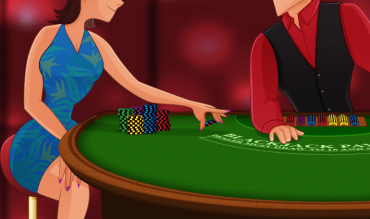In this article I will explain what to do against a dealer's 2 upcard in a game of blackjack, which is one of the most popular online casino games.
At first glance, the dealer’s 2 (or deuce) upcard seems to be an innocuous card. Yet, you would be surprised at how many players misplay their hands against a deuce. The correct way to play your hand depends on what you are dealt, the number of decks of cards being used, and the mix of playing rules.
I’ll begin explaining the strategy using a base game, specifically, a multi-deck game with S17 and DAS. I’ll use the following standard notations.
S17 = Dealer must stand on soft 17
H17 = Dealer must hit soft 17
DAS = Doubling down after pair splitting is allowed
NDAS = Doubling down after pair splitting is not allowed
H = Hit
S = Stand
P = Split
Dh = Double down if allowed; otherwise, hit
Ds = Double down if allowed; otherwise, stand
Table of Contents
MULTI-DECK GAME WITH S17 AND DAS
Against a dealer’s 2 upcard, you should play your hands as follows.
Hit if holding:
• Hard 5 through 9, and 12
• A-2 through A-6
• Pair of 4s.
Stand if holding:
• Hard 13 through17
• A-7 or A-8
• Pair of 10s.
Split if holding:
• Pair of As, 2s, 3s, and 6s through 9s.
Double down if allowed, otherwise hit, if holding:
• Hard 10 and 11
• Pair of 5s.
Below is the corresponding playing strategy arranged into three color-coded tables for Hard Hands, Soft Hands, and Pairs. The first row represents the player’s hand (in the case of hard hands, it represents the total count of the cards), and the second row contains the correct playing strategy against a dealer’s 2 upcard with S17 and DAS.
Hard Hands
Soft Hands
Pairs
WHAT IF THE RULES ARE NDAS INSTEAD OF DAS?
If the rules specify NDAS, the strategy is the same except for the following:
• Hit a pair of 2s, 3s, and 6s (instead of split).
The color-coded strategy chart for a multi-deck game with NDAS for pairs is:
WHAT IF THE RULES ARE H17 INSTEAD OF S17?
If the rules specify H17 (as opposed to S17) there is one additional strategy change to the above multi-deck strategy with S17 and DAS (or NDAS). Against a dealer’s 2 upcard
• Double down on A-7 (if permitted); otherwise, stand.
The corresponding color-coded strategy table for soft hands with H17 is:
WHAT IF YOU ARE PLAYING A DOUBLE-DECK GAME?
The playing strategy against a dealer’s 2 upcard in a double-deck game (with DAS or NDAS) is identical to the corresponding multi-deck game except for two strategy changes:
• Double-down on hard 9 if allowed (instead of hitting); otherwise, hit
• If the rules are NDAS, split 6s (instead of hitting).
WHAT IF YOU ARE PLAYING A SINGLE-DECK GAME?
Compared to the above multi-deck playing strategy against a dealer’s 2 upcard, there are several strategy changes:
• Double-down on hard 9 if allowed (instead of hitting); otherwise, hit
• Double-down on A-6 if allowed (instead of hitting); otherwise, hit
• If the rules are h17, stand on soft 18 if allowed (instead of doubling)
• If the rules are NDAS, split 6s (instead of hitting)
PRACTICE PLAY
To be sure you have the strategy down pat for playing your hand against a dealer’s 2 upcard, determine how you would play each of the ten hands listed below, jot down your decision on paper, and then check it against the correct play at the end of this article. (Your goal is to be able to play every hand accurately, regardless of the number of decks of cards or mix of playing rules.)
Correct play for the hands in the table is:
